



OECD - FAO Agricultural Outlook 2011-2020
Global commodity prices are expected to fall from their 2010/2011 levels but the markets are also expected to remain volatile according to a new report from the OECD and FAO prepared for the G20 meeting in Paris this month.
A period of high volatility in agricultural commodity markets has entered its fifth successive year. High and volatile commodity prices and their implications for food insecurity are clearly among the important issues facing governments today. This was well reflected in the discussions at the G20 Summit in Seoul in November, 2010, and in the proposals for action being developed for consideration at its June 2011 meeting of Agriculture Ministers in Paris.
This Outlook is cautiously optimistic that commodity prices will fall from their 2010-11 levels, as markets respond to these higher prices and the opportunities for increased profitability that they afford. Harvests
this year are critical, but restoring market balances may take some time. Until stocks can be rebuilt, risks of further upside price volatility remain high. This Outlook maintains the view expressed in recent editions that agricultural commodity prices in real terms are likely to remain on a higher plateau during the next ten years compared to the previous decade. Prolonged periods of high prices could make the achievement of global food security goals more difficult, putting poor consumers at a higher risk of malnutrition.
Higher commodity prices are a positive signal to a sector that has been experiencing declining prices expressed in real terms for many decades and are likely to stimulate the investments in improved productivity
and increased output needed to meet the rising demands for food. However, supply response is conditioned by the relative cost of inputs while the incentives provided by higher international prices are not always passed through to producers due to high transactions costs or domestic policy interventions. In some key producing regions, exchange rate appreciation has also affected competitiveness of their agricultural sectors, limiting production responses (see Figure 1).
There are signs that production costs are rising and productivity growth is slowing. Energy related costs have risen significantly, as have feed costs. Resource pressures, in particular those related to water and land, are also increasing. Land available for agriculture in many traditional supply areas is increasingly constrained and production must expand into less developed areas and into marginal lands with lower fertility and higher risk of adverse weather events. Substantial further investments in productivity enhancement are needed to ensure the sector can meet the rising demands of the future.
Figure 1. Net agricultural production
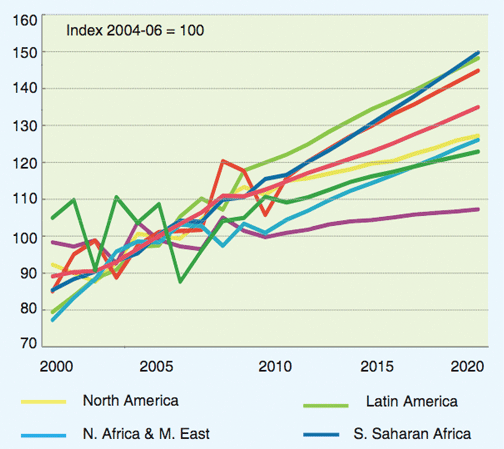
Figure 2. Per capita food consumption

Highlights
Agricultural production is expected to increase in the short term, assuming normal weather, as a result of an expected supply response to current high prices. Commodity prices should fall from the highs of early 2011, but in real terms are projected to average up to 20 per cent higher for cereals (maize) and up to 30 per cent for meats (poultry), over the 2011-20 period compared to the last decade. Increases in commodity prices are now moving down the commodity chain into livestock commodities (see Figure 3).
As higher prices for commodities are passed through the food chain, recent evidence indicates that consumer food price inflation is currently rising in most countries, contributing to higher aggregate consumer price inflation. This raises concerns for economic stability and food insecurity in some developing countries as the purchasing power of poorer populations is reduced.
Global agricultural production is projected to grow at 1.7 per cent annually, on average, compared to 2.6 per cent in the previous decade. Slower growth is expected for most crops, especially oilseeds and coarse grains, which
face higher production costs and slowing productivity growth. Growth in livestock production stays close to recent trends. Despite the slower expansion, production per capita is still projected to rise 0.7 per cent annually.
The global slowdown in projected yield improvements of important crops will continue to exert pressure on international prices. Higher production growth is expected from emerging suppliers where existing
technologies offer good potential for yield improvements, although yield/supply variability may be higher. The share of production from developing countries continues to increase over the outlook period.
The fisheries sector, which is covered for the first time in this Outlook, is projected to increase its global production by 1.3 per cent annually to 2020, slower than over the previous decade due to a lower rate of growth of aquaculture (2.8 per cent against 5.6 per cent for 2001-2010) and a reduced or stagnant fish capture sector. By 2015, aquaculture is projected to surpass capture fisheries as the most important source of fish for human consumption, and by 2020 should represent about 45 per cent of total fishery production (including non-food uses). Compared to the 2008-2010 period, average capture fish prices are expected to be about 20 per cent higher by 2020 in nominal terms compared with a 50 per cent increase for aquaculture species.
Per capita food consumption will expand most rapidly in Eastern Europe, Asia and Latin America where incomes are rising and population growth is slowing (see Figure 2). Vegetable oils, sugar, meat and dairy products should experience the highest increases in demand.
Figure 3. Price trends of agricultural commodities to 2020 (nominal)
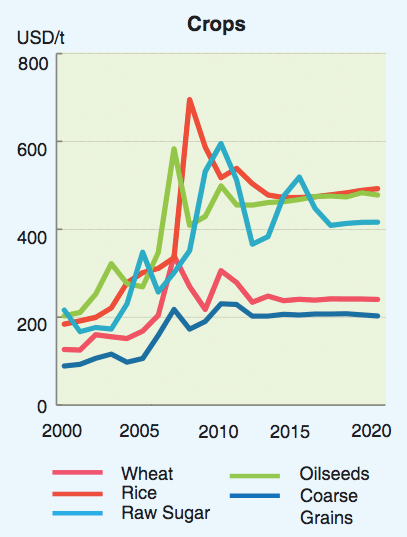
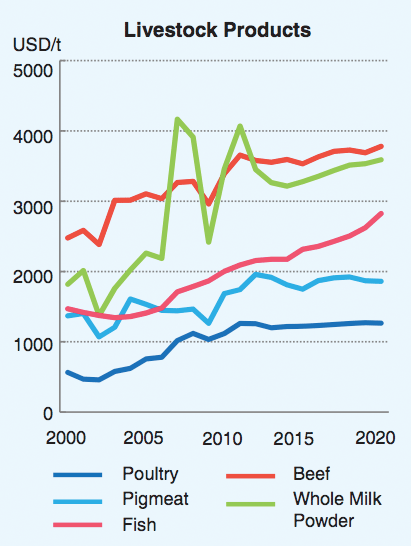
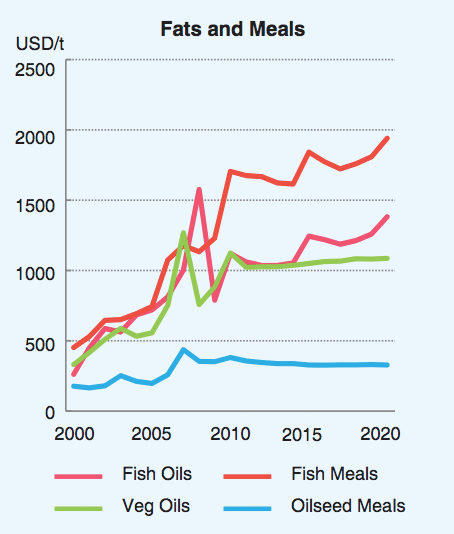
The use of agricultural output as feedstock for biofuels will continue its robust growth, largely driven by biofuel mandates and support policies. By 2020, an estimated 13 per cent of global coarse grain production, 15 per cent of vegetable oil production and 30 per cent of sugar cane production will be used for biofuel production. Higher oil prices would induce yet further growth in use of biofuel feedstocks, and at sufficiently high oil prices, biofuel production in many countries becomes viable even in the absence of policy support.
Trade is expected to grow by 2 per cent per year, which is slower than over the previous decade, with only modest production increases by traditional exporters and higher domestic production by importers. The fastest growth will come primarily from emerging exporters in Eastern Europe, Central Asia and Latin American countries. Growing food deficits are expected in Sub-Saharan countries as population driven demand outpaces rising domestic production.
Stochastic analysis demonstrates the uncertainty of the price projections, which are highly dependent on the underlying assumptions, and suggests the risk of higher prices is greater than lower prices. This analysis also confirms that yield induced production fluctuations in major crop exporting countries have been a prime source of international price volatility. Last year’s drought and fires in the Russian Federation and the Ukraine, and excess moisture in the United States illustrated how quickly market balances can change. Weather-related crop yield variations are expected to become an even more critical driver of price volatility in the future.
Figure 4. Model scenarios show key sensitivities in the Outlook.
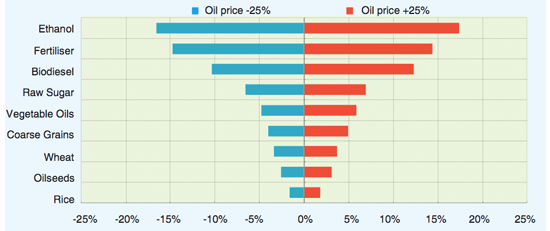
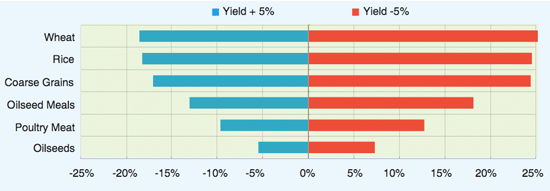
Price volatility
The Outlook takes a look at the key forces driving price volatility (see Figure 4 for examples), which create uncertainty and risk for producers, traders, consumers and governments. Price volatility can have extensive negative impacts on the agriculture sector, food security and the wider economy in both developed and developing countries.
- Weather and climate change - The most frequent and signifi cant factor causing volatility is unpredictable weather conditions. Climate change is altering weather patterns, but its impact on extreme weather events is not clear.
- Stock levels - Stocks have long played a role in mitigating discrepancies in short term demand and supply of commodities. When accessible stocks are low relative to use, as they currently are for coarse grains, price volatility may be high.
- Energy prices - Increasing links to energy markets through both inputs such as fertiliser and transportation, and through biofuel feedstock demand, are transmitting price volatility from energy to agricultural markets.
- Exchange rates - By affecting domestic commodity prices, currency movements have the potential to impact food security and competitiveness around the world.
- Growing demand – If supply does not keep pace with demand, there will be upward pressure on commodity prices. With per capita incomes rising globally and in many poor countries expected to increase by as much as 50 per cent, food demand will become more inelastic such that larger price swings would be necessary to affect demand.
- Resource pressures - Higher input costs, slower technology application, expansion into more marginal lands, and limits to double-cropping and water for irrigation, are limiting production growth rates.
- Trade restrictions – Both export and import restrictions amplify price volatility in international markets.
- Speculation - Most researchers agree that high levels of speculative activity in futures markets may amplify price movements in the short term although there is no conclusive evidence of longer term systemic effects on volatility.
Policy challenges
This Outlook highlights both significant challenges to addressing global food insecurity and the major opportunities for food and agricultural producers arising from the higher average prices projected over the coming decade. The policy challenge is to promote productivity growth, particularly for small producers, that improves market resilience to external shocks, and that reduces waste and increases supplies to local markets, at affordable prices. Public sector investments are required in agricultural research and development, institutions and infrastructure to increase sector productivity and resilience towards weather/climate change and resource scarcity. Investments are required to reduce post harvest losses. Recognizing that volatility will remain a feature of agricultural markets, coherent policies are required to both reduce volatility where possible and to limit its negative impacts.
- Mitigating volatility – Enhanced market transparency can reduce price volatility. Greater efforts are required to improve global and national information and surveillance systems on market prospects, including better data on production, stocks and trade in sensitive food security commodities. Removal or reduction of policy distortions such as restrictions on imports and exports or biofuel subsidies and mandates can also reduce price volatility. Information and transparency in futures markets should be improved recognizing the importance of harmonizing measures across exchanges.
- Managing volatility – Social safety nets can assist the most vulnerable consumers when food prices rise while producer safety-nets can offset low incomes, thereby maintaining their ability to purchase inputs and maintain production. Emergency food reserves for targeted assistance to poor people are useful to lessen the impact of high prices. Greater efforts are required to make market-based risk management schemes, including the use of forward contracting and commodity futures exchanges, available to smaller producers. Governments can also adopt certain risk management strategies such as insurance to finance food imports when poor weather reduces domestic production or option contracts to lock in future food import purchases.


